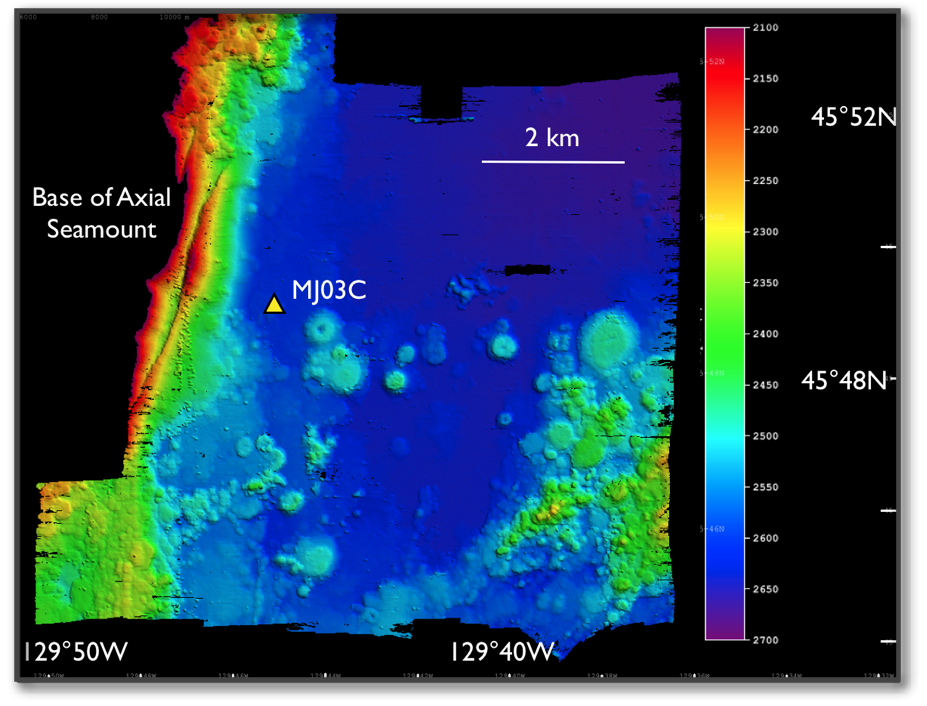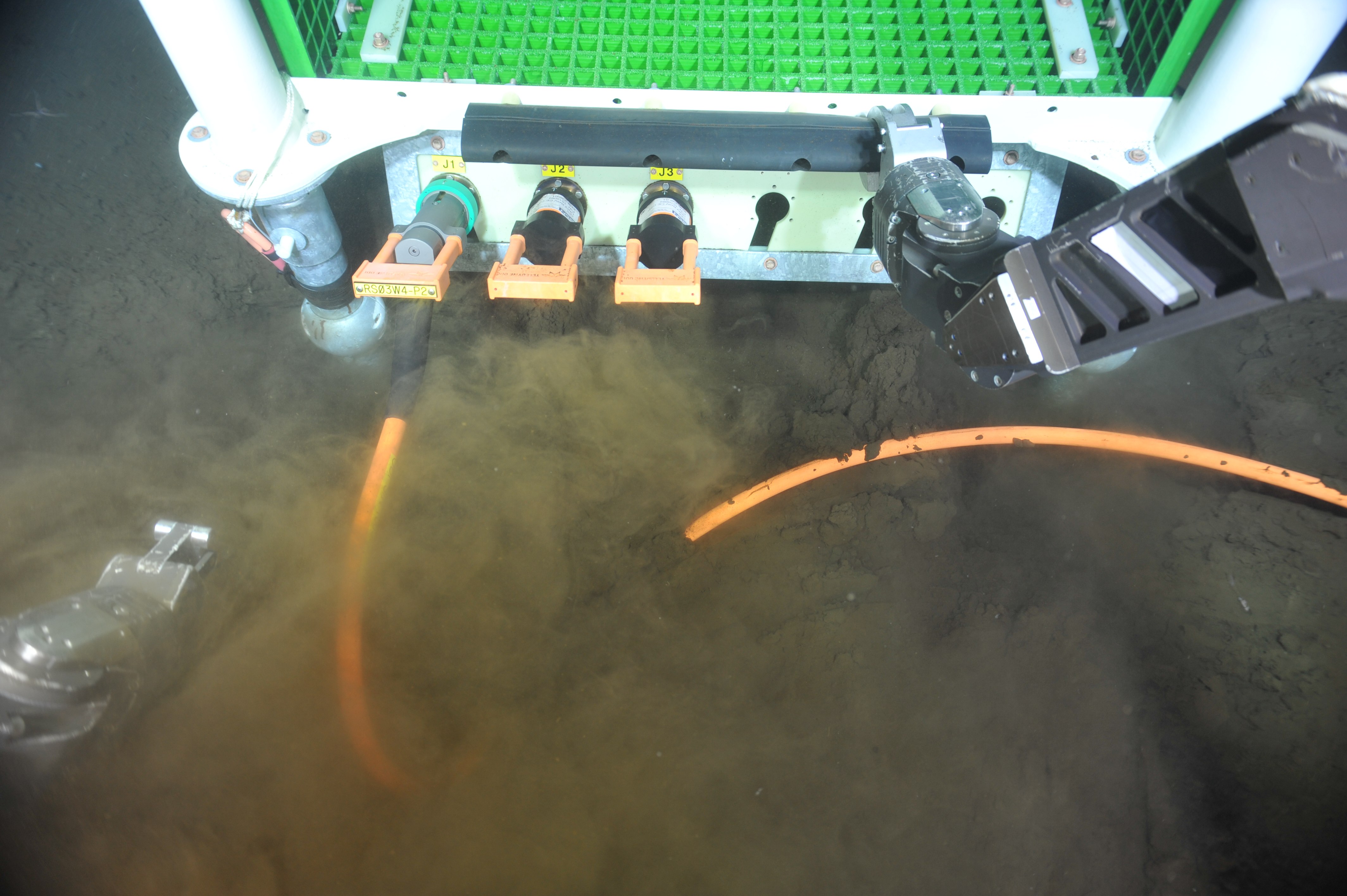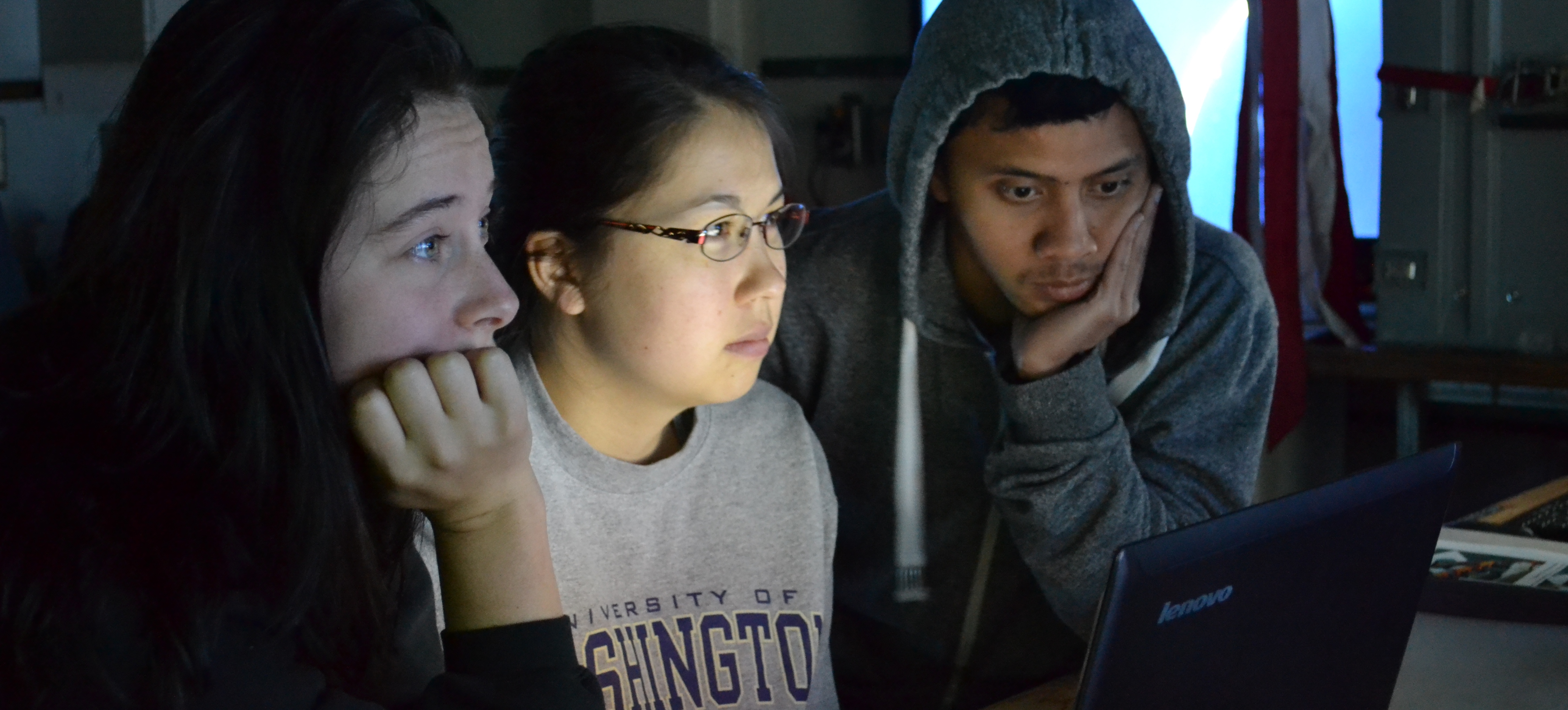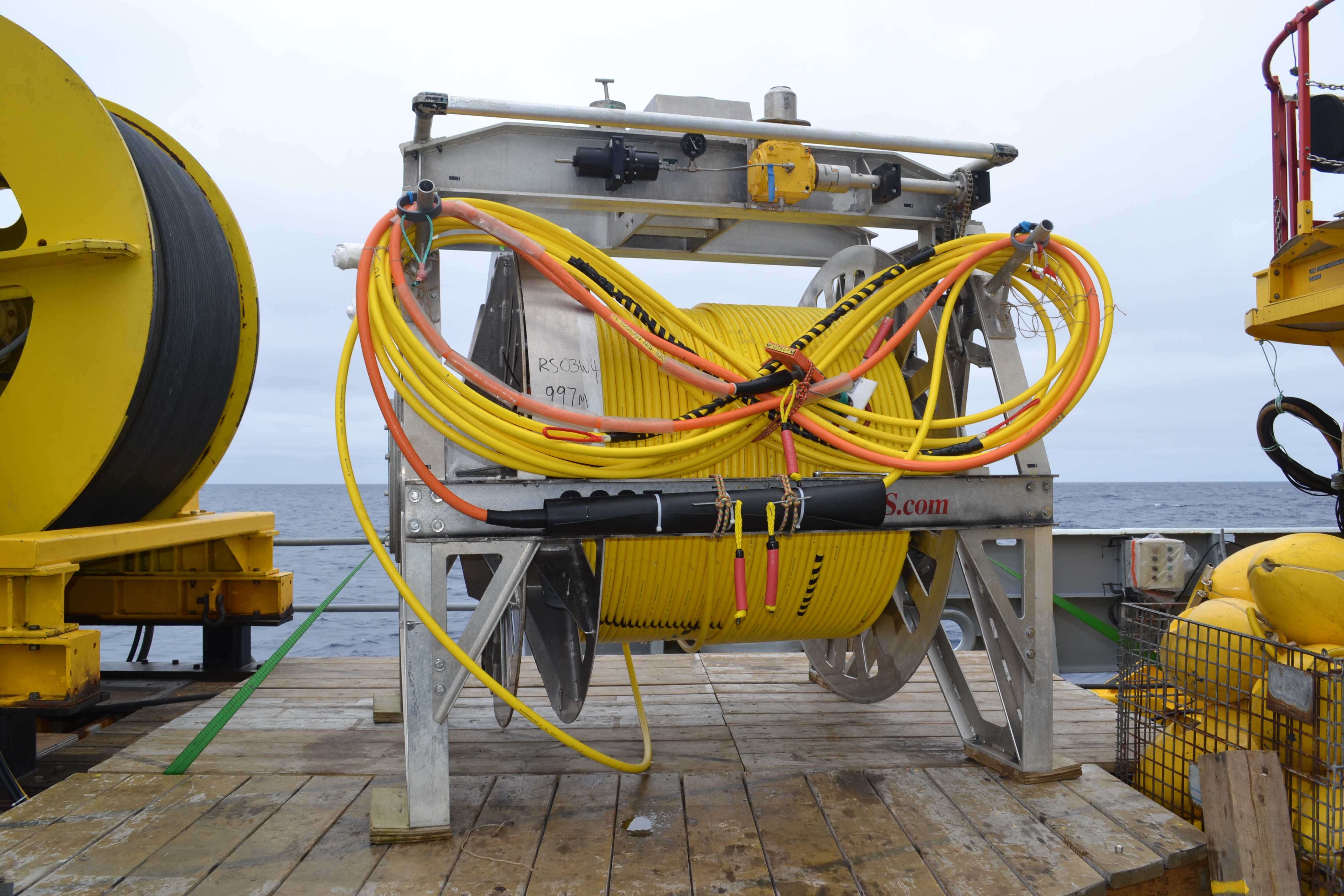Image Archive





























Brendan Philip, a recent graduate from the School of Oceanography undergraduate program, designed and ran this EM302 bathymetric survey in the area where two RSN-OOI moorings will be installed at the base of Axial Seamount. Photo credit: Deb Kelley, University of Washington, V14.

The ROV ROPOS has an RSN-OOI , medium-powered junction box, MJ03C, secured to its underbelly for transport to the International District hydrothermal vent field. The junction box will provide power and communication to a diverse suite of chemical, temperature, and biological sensors, in addition to a digital still camera. Photo credit: NSF-OOI/UW/CSSF; Dive R1717; V14.

Dana Manalang and Eric Olsen (UW) work with UW students Gina Hansen and Don Setiawan to.prepare the end of a fiber optic cable segment so that it can be spooled by hand onto the large cable spool. The spool will then be transported by ROCLS for installation on the seafloor. Photo credit: Mitch Elend, University of Washington, V14.

Leg 1 University of Washington participants Skip Denny, Katie Bigham and Sam Albertson watch ROPOS' progress during dive R1716. Each action viewed and recorded on HD video must be carefully logged and documented with still photographs. Photo credit: NSF-OOI/UW/CSSF; Dive R1716; V14.

Holothurians and brittle stars at the base of Axial Seamount. Photo credit: NSF-OOI/UW/CSSF; Dive R1717; V14.

The 1 km extension cable from the Primary Node PN3A at the base of Axial Seamount is connected to the low voltage node LV013A, which will feed the two moorings at this site. Photo credit: NSF-OOI/UW/CSSF; Dive R1717; V14.

Students who participate on VISIONS cruises are fully engaged in the scientific pursuits while onboard the R/V Thompson, including the detailed logging of ROV ROPOS dives. Photo credit: Mitch Elend, University of Washington, V14

A Big Red jellyfish (Tiburonia granrojo) swims past the high-definition camera on the remotely operated vehicle ROPOS. The water depth was 1547 m (5075 ft) beneath the ocean's surface. Credit: UW/NSF-OOI/CSSF; ROPOS Dive R1716; V14.

ROPOS uses a T-handle to latch into the top of the ROCLS cable drum. Photo Credit: NSF-OOI/UW/CSSF; Dive R1716; V14.

Several species of macrofauna inhabit the thick sediments at the base of Axial Seamount. A large sea cucumber deep sea Holothurian coexists with abundant brittle stars and Peniagone sea cucumbers. Photo Credit: NSF-OOI/UW/CSSF; Dive R1715; V14.

This large sea cucumber (Holothurian) was seen with many smaller sea cucumbers of Genus Peniagone at the base of Axial. Photo Credit: NSF-OOI/UW/CSSF; Dive R1715; V14.

The ROV ROPOS is one of only a very few robotic vehicles that can install extension cables deep beneath the ocean's surface. Here, numerous screens provide updates on the postion of the R/V Thompson 8500 feet above the vehicle, the location of ROPOS, and cable lay information. This image was taken during Dive R1715, installation of the first cable on the VISIONS '14 expedition. Photo Credit: Mitch Elend, University of Washington; V14.

The ROCLS cable drum is unlatched on the seafloor at the base of Axial Seamount near PN3A at a depth of 2600 m. The cable, once plugged into a junction box and Primary Node, will power and communicate with ~2600 m-tall (8500 ft) instrumented moorings, as well as seafloor instruments. Photo Credit: NSF-OOI/UW/CSSF; Dive R1715; V14.

Cable RS03W4, a 1 km extension cable, sits on the ROPOS work platform awaiting attachment to ROCLS on the underbelly of the ROV ROPOS. Photo Credit: NSF-OOI/UW/CSSF; Dive R1715; V14.

The ROPOS remotely operated cable laying system (ROCLS) is awaiting attachment to the underbelly of ROPOS. The cable will be installed at the base of Axial Seaount. Photo Credit: Mitch Elend, University of Washington, V14.

John Wonderly, from Clallam Bay school, collects fluid samples during the VISIONS14 expedition. Photo Credit: Mitch Elend, University of Washington; V14.

Gina Hansen, University of Washington Bioengineering student, helps takes water samples collected at ~ 9000 ft beneath the ocean's surface near Axial Seamount (volcano). Photo Credit: Mitch Elend, University of Washington, V14.

Keith Shepherd, Operations Manager for the Canadian Scientific Submersible Facility, oversees the lauch of ROPOS for Dive R1713. Photo Credit: Mitch Elend, University of Washington; V14.

On a beautiful sunny day, the ROV ROPOS is launched from the R/ V Thompson. Photo credit: Mitch Elend, University of Washington; V14.

The anhydrite chimney 'Diva' visited with the ROV ROPOS during the VISIONS'14 program. This is an extremely CO2-rich vent with temperatures measured at 294°C (561°F) in July.

The top of the 16-m tall El Guapo edifice that emits boiling fluids. Credit: UW/NSF-OOI/CSSF; ROPOS Dive R1713; V14.

A novel gas-tight fluid sampler takes a sample of 271°C (~520°F) fluid venting from the Escargot chimney in the International District hydrothermal field on Axial Seamount. Credit: UW/NSF-OOI/CSSF; ROPOS Dive R1713; V14.

Beautiful blue ciliates (protists) line the base of the hydrothermal vent called El Gordo. Credit: UW/NSF-OOI/CSSF; ROPOS Dive R1713; V14

During Dive R1273, the 271°C venting orifice was visited at Escargot and a gas-tight fluid sample was taken. The srtucture is named after its morphology, which clearly resembles a snail. Photo Credit: NSF-OOI/UW/CSSF; Dive R1713; V14.

The CTD (Conductivity-Temperature-Depth sensor) is deployed into the ocean. All of the Niskin bottles are held open before deployment and are closed individually to collect water samples at different depths as the CTD carousel rises through the water column. Photo credit: John Wonderly, Clallam Bay School, V14.

Leg 1 students assist ship's crew to deploy the CTD. Photo credit:

Students on VISIONS 14 Leg 1 discuss one of the readings on the bow of the Thompson. Photo credit: Leslie Sautter, College of Charleston, V14.

The Conductivity, Temperature and Depth (CTD) probe lies within a large carousel of Niskin water bottles. The carousel is lowered to the seafloor while the CTD makes measurements. On the 'ride' up, a person on deck triggers the water bottles to close (one at a time) to collect a water sample at different depths. Photo credit: Mitch Elend, University of Washinton, V14.
- Anemone
- Animal
- Arthropod
- ASHES
- Axial
- Axial Base
- Axial Biology
- Axial Caldera
- Bacteria
- Basalt Lava
- BEP
- Biofouling
- biolgoy
- Biology
- Camds
- Camera
- Camhd
- Central Caldera
- Ciliates
- Cnidaria
- Coastal Biology
- Crab
- Deep Profiler Mooring
- Dive Highlights
- Eastern Caldera
- Echinoderms
- Endurance Array
- Engineering Team
- ENLIGHTEN 10
- Exploratorium
- Fish
- Geology
- HD Camera
- HPIES
- Hydrate Ridge
- Hydrates
- Hydrophone
- Hydrothermal Vents
- Illustration
- Inshore 80 Meters
- Instrument
- International District
- J-BOX
- Jason
- Jellyfish
- Junction Box
- K12
- Lava
- Mollusk
- Moorings
- Nodes
- Nudibranch
- Octopus
- OOI
- Oregon Offshore
- Oregon Offshore 600 m
- Oregon Shelf
- Oregon Slope Base
- People
- PN1B
- PN1D
- Polychaetes
- PPSDN
- Primary Node
- RASFL
- ROCLS
- ROPOS
- ROPOS Dives
- ROV Team
- RV Revelle
- RV Sikuliaq
- RV Thompson
- Salp
- Sample
- SC13
- Science Team
- Sea Cucumber
- Sea Star
- Sea Urchin
- Seafloor
- Seismometer
- Sensors
- Shallow Profiler Mooring
- Shark
- Shipboard
- Shore Station
- Slope Base
- Smoker
- Soft Coral
- Southern Hydrate Ridge
- Sponge
- Squid
- Students
- Students & Guest Participants
- Tmpsf
- Tubeworms
- VISIONS 11 Leg 1
- VISIONS 11 Leg 2
- VISIONS 11 Viewers
- VISIONS 13
- VISIONS 14
- VISIONS 15
- VISIONS 16
- VISIONS 17
- VISIONS 18
- VISIONS 20
- VISIONS 22
- VISIONS 23
- Visualization
